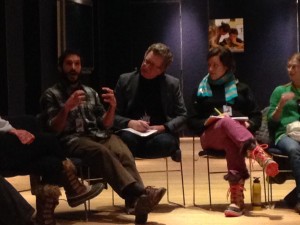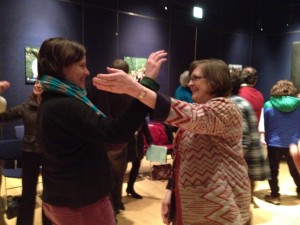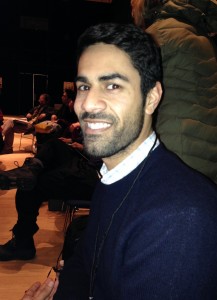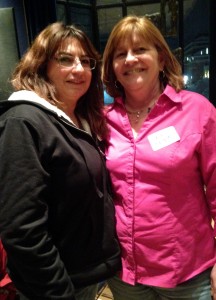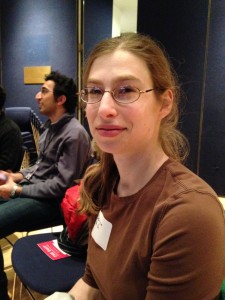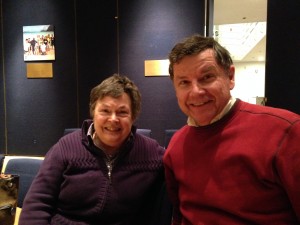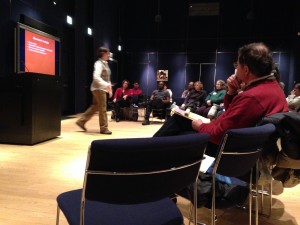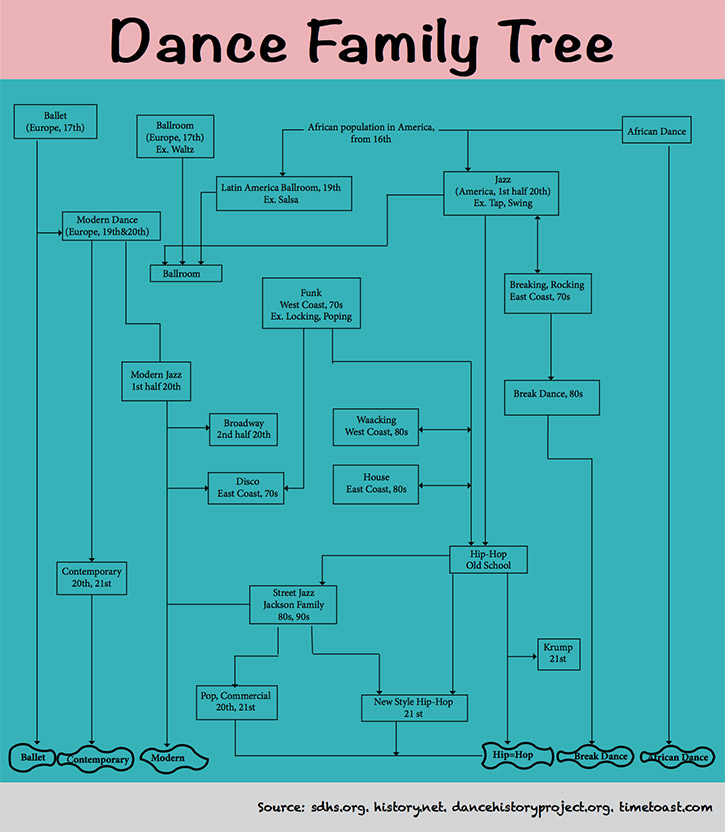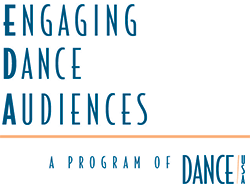UMS Night School: Bodies in Motion – Session 4 Recap
Editor’s note: This post is a part of a series of by U-M student Sarah Squillante, who’s covering our free UMS Night School: Bodies in Motion series. Learn along side with them.
Does a discussion of theatre belong in a Night School series devoted to dance? Is there a place for opera, on-stage violence, even music? After Monday’s UMS Night School session, most attendees would probably say that it does.
Host Clare Croft reminded attendees that there are multiple ways to enter a performance. Even in theatre, she said, it’s useful to pay attention to movement and ask ourselves: How are performers using the space? What can we learn about the characters from how they move or stand? She introduced four speakers who offered their personal take on the upcoming performance of Théâtre des Bouffes du Nord’s production of The Suit, directed by Peter Brook.
Naomi Andre, U-M Associate Professor of Women’s Studies, explained the significance of South African opera, reminding participants of dance-like qualities of voice performance. UMS Campus Engagement Specialist, Shannon Fitzsimons, spoke about legendary theatrical director Peter Brook, and touched on his “sense of visual economy” and “commitment to emotional truth,” among other details. UMS Director of Programming, Michael Kondziolka, touched on his skepticism before seeing the performance for the first time and his reasons for selecting the piece. He noted that it is really “telling a story about the movement of bodies.” Finally, Rob Najarian, U-M Assistant Professor of Theatre and former fight/violence director, encouraged attendees to think about the “shared experience” between audience and performer. He led a movement exercise that illustrated the deliberate nature of movement.
Attendees also had a chance to reflect on the past weekend’s performances of Compagnie Kafig, demonstrating a movement that embodied the show to share with the group; many found that the troupe had an incredible amount of athleticism and humor.
One attendee noted that her experience at the You Can Dance workshop affected her viewing of Compagnie Käfig: “It wasn’t the type of move that makes you go to your friends and say, ‘wow did you see that?’ but I really noticed the intricacy and complexity in movements that seem so simple,” U-M graduate and frequent Night School attendee Sasha Kapshai said.
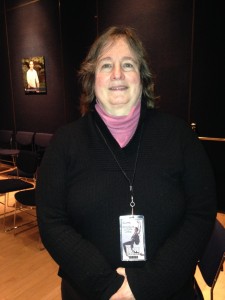
Attendee Jane Michener didn’t have plans to see The Suit before the evening, but then changed her mind. “I’m intrigued by all the intricacies of how it’s put together,” she said.
Session 5 of Night School, Body Experiments, will explore ways in which dancers experiment and create new ideas in dance, preparation for Jennifer Monson and DD Dorvillier’s RMW(a)/RMW, and discussion of The Suit. Special guests include: Anita Gonzalez, U-M Professor of Theatre and Drama, Amy Chavasse, U-M Associate Professor of Dance, Larry La Fountain-Stokes, U-M Associate Professor of American Culture, Gillian Eaton, U-M Assistant Professor of Theatre, and Rob Najarian, U-M Assistant Professor of Theatre.
The upcoming weekend is full of dance-related viewing opportunities! Check out the Dance on Camera Festival at the University of Michigan Museum of Art and the UMS performance of Théâtre des Bouffes du Nord: The Suit, 2/19-2/22 at the Power Center.
Session 4 Resources
- Excerpt from Peter Brook’s The Open Door
Interested in even more dance engagement? Pick up an adventure card to learn all about the dance activities we’re offering this year and for a chance to win a backstage meet and greet.
For a complete list of 2013-2014 dance performances, visit ums.org. Share questions, comments, or suggestions in the comments below.
UMS Night School: Bodies in Motion – Session 3 Recap
Editor’s note: This post is a part of a series of by U-M student Sarah Squillante, who’s covering our free UMS Night School: Bodies in Motion series. Learn along side with them.
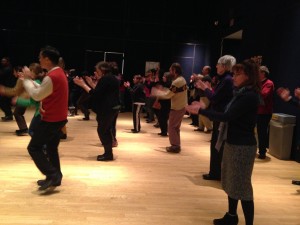
UMS Night School attendees danced to a new beat this week – literally. Midway through the session, attendees were asked to get up on their feet, learn a basic Capoeira step, and then free-style in a large circle to funk music. The movement exercise, led by U-M Dance MFA Candidate Marcus Whiten, gave attendees a kinesthetic taste of a distinct style – a mix of hip hop, martial arts, and acrobatics – that Compagnie Käfig will bring to Ann Arbor this weekend, February 14 and 15.
This week also marked the beginning of a new format in which attendees have the opportunity to discuss a recent dance performance. This week’s discussion centered around “Moving Pictures,” a concert featuring 4 works performed by the U-M department of Dance. In a short panel discussion, three dancers spoke first of the larger ideas that they were asked to conceptualize during the beginning stages of the pieces, then progressed to more specific elements of the performance, like costuming and live music. The dancers expressed delight in the challenges that the pieces provided and in the connections that they were able to make with the audience.
The attendees comprised a diverse a group as usual, ranging from experienced dancers to those who had never seen a performance before. The class has grown significantly since the first week. Some have become Night School “regulars,” while others ventured out into the cold for the first time.
In the left photo, newcomer Razi Jafri said he came because he “didn’t really know anything about dance – artistically or technically,” so he figured it’d be a good introduction.
On the right, Lucie Cohen and Deb Taylor came to Night School thinking they’d be seeing a dance performance, but were pleasantly surprised by the discussion format. “I really enjoyed getting involved when we started moving. The proximity of our bodies made me feel like I knew people on a personal level,” Lucia said.
Leslie Woldenberg, a dance lover and frequent UMS patron, drove all the way from Toledo with a friend to experience Night School for the first time.
The session finished with a short talk from Reighan Gillam, Postdoctoral research fellow in the U-M Department of Afroamerican and African Studies, who spoke about the origins of hip-hop music and dance in Brazil. Gillam emphasized the fact that rappers come from the periphery of Brazil and that, much like hip hop in the United States, the content typically revolves around the violence and system inequality characteristic of marginalized groups.
The details – and the questions they inspired – were intended to help attendees frame their viewing of Compagnie Käfig. Night School host Clare Croft suggested that attendees use information from the lecture to consider how the atmosphere in Brazil may impact the movement they see on stage.
The fourth session of Night School will include an exploration of how actors think about movement, with a preparation for Théâtre des Bouffes du Nord’s The Suit, and also a discussion of Compagnie Käfig’s Correria Agwa. Special guests will include: Naomi Andre, U-M Associate Professor of Women’s Studies, Rob Najarian, U-M Assistant Professor of Theatre, and Michael Kondziolka, UMS Director of Programming. It will be held at the U-M Alumni Center at 200 Fletcher Street at 7 PM.
Session 3 Resources & Readings
- UMS Learning Guide on Compagnie Käfig
- Performance prep reading on Capoeira – “Headspin” by Barbara Browning
- Bodies in Motion Session 3 – Key Themes, Players, and Definitions [Word Document assembled by Marcus White, MFA Candidate – Dance, University of Michigan]
- Session 4 Prep Reading: Excerpt from Peter Brook’s The Open Door
Interested in even more dance engagement? Pick up an adventure card to learn all about the dance activities we’re offering this year and for a chance to win a backstage meet and greet.
For a complete list of 2013-2014 dance performances, visit ums.org. Share questions, comments, or suggestions in the comments below.
Interview: Kelvin Wyatt, Instructor at Tabcat Detroit
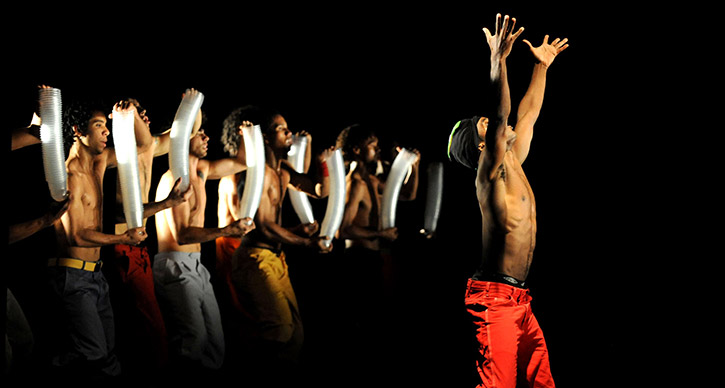
Photo: Compagnie Käfig, a dance company drawing on capoeira, performs in Ann Arbor on February 14-15, 2014. Photo by Michel Cavalka.
Recently, I had the chance to join in on a workshop with Tabcat Detroit, a Detroit-based dance group that teaches and performs a Brazilian folkloric dance called capoeira. We’re presenting Compagnie Käfig, a dance company that’s cross-polinating across genres and incorporating athletic samba, hip-hop, martial arts, capoeira dance, and even acrobatics into their style, on February 14-15, 2014, and we wanted to know more about the capoeira community locally.
As a ballerina, I was out of my element – banging on a drum and straining to mimic the Brazilian chanting – but in awe of what I could only describe as graceful athleticism. I had jumped at the opportunity to explore capoeira firsthand, but now, as the instructor was urging me to show off what I had learned during the hour in the center of the circle, I was feeling a bit apprehensive. My hips had grown sore from all the crouching, and I still wasn’t sure about the sequence of the steps. But as I floated around the room, squatting and kicking and singing, I experienced the elegance in this ancient dance form.
After class, I sat down with the group’s main instructor, Treinel Pequenininho (Kelvin Wyatt), to learn more about capoeira and his specific experiences with the art form.
Sarah Squillante (UMS): What is your background in capoeira?
Kelvin Wyatt: I’ve been training in capoeira for about 16 years. Seven years ago, I started training in traditional Capoeira Angola of Bahia. My interest began in high school, after I saw capoeira for the first time in a movie called Only the Strong. The next day at school, I met this new person named Tadarius in art class. And as I was riding my bike home, I watched somebody doing cartwheels and kicks in front of his house, and I flipped off my bike. When I got up and went over, it turned out to be Tadarius, the same person I had met in art class.
He told me he was training with a group on the west side of Detroit. So from there, I trained and trained. I really believe that the universe made it possible for me to meet Tadarius and give me a means for my journey in capoeira.
I met Mestre Caboclinho, a master in capoeira Angola of Brazil, in 1999 at a workshop that was given at the Serengeti Ballroom in downtown Detroit. In 2007, I came across him again. Mestre Caboclinho emphasized on the complete culture of capoeira, not just throwing kicks. He took me under his wing and helped make me the person I am today in capoeira. I’ve been teaching now since 2009.
SS: Where does capoeira come from? Can you tell me more about the art form?
KW: Capoeira itself is an art that was developed over 500 years ago by Africans in Brazil to celebrate life. The art is a mixture of African and Portuguese influences. Its purpose is to disguise self-defense into a dance and a game. Capoeira combines dance, music, song, acrobatics, and philosophy.
Acrobatics, in itself is a test of individuals, their capacity, what they can actually do inside of capoeira. Everybody has thought of that word, fear. But in capoeira, you don’t have fear anymore because it helps you let it go.
SS: Do you think capoeira is more of a dance or a martial art?
KW: For me, dance. I say dance because most of the time, especially for Americans, when people hear martial art, they always think fight fight fight, but the philosophy and everything inside of capoeira is that the strength is there, but you need to know your patience.
Even in the self-defense aspect, it’s all a game. If you have someone come to you and they’re using all their strength, it just knocks you off your feet. But if you move out of the way, it’s surprising. The attacker thinks, wait he’s escaping? He’s swaying out of the way? How did he do that? He did it again. Now I’ve let you fall into my game. Now I smile. In capoeira, we always smile. And then it’s like: Why is he smiling now? It’s capoeira.
SS: What makes capoeira challenging?
KW: I look at it as growth. It might be a challenge to people if they’ve never done an acrobatic move before, if they’ve never done a cartwheel or spoken a different language before. But with that in mind, if you have the capacity to learn, it’s not going to be a challenge.
SS: What makes it rewarding?
KW: What makes it rewarding is that we all have one goal. One goal may be to want to learn how to do a cartwheel, or to play all eight instruments. You set these goals, and these goals enrich life because capoeira teaches a lot about life. Some people come with really bad road rage. Capoeira helps them calm down. Some people just want a work out.Ccapoeira helps them work out. It touches everybody in a different way.
SS: Does Tabcat Detroit perform?
KW: Other than teaching regular capoeira classes, we do performances as well. This year, we performed for the Detroit Tigers, during Fiesta Tigre, at the main entrance to Comerica Park. There were thousands and thousands of people. What is this? They spin on their head, they do this, they jump in the air, they do no-handed cartwheels. capoeira – it’s here in Detroit. We’ve also performed for the College of Creative Studies, and at the University of Michigan, at an annual performance that we do for one of the professors. We’ve done a performance for the Kwanzaa celebration at the Charles H. Wright Museum in downtown Detroit as well.
SS: The movements are so graceful that they almost seem pre-choreographed.
KW: Capoeira is supposed to be natural. You have some people that practice capoeira as a choreographed art. They give each other signals. But traditional capoeira – the capoeira Angola that we teach – has more philosophy, more understanding.
SS: How has capoeira impacted the Detroit community?
KW: Everybody just looks at Detroit as far as the negative, not the positive. Granted, there are a lot of neighborhoods going down and things like that, but there are actual people in the city that do care. The work that I (and the people before me) have done for 14 years is to bring capoeira here so everybody could be happy.
I have seen it make the angriest person smile. I have seen it make someone cry. I have seen people take what they thought they couldn’t do and change it into something they could do. This has helped people learn that the tools are actually there.
I’ve seen it bring communities together. We’ve done performances where we play the berimbau [bow-like instrument] and batucada [a percussive, African-influenced Brazilian style of samba] through actual neighborhoods. People come out and they’re like: What’s that?
SS: How has capoeira impacted your life personally?
KW: Capoeira has helped me look at a lot of things that I thought were impossible and I find out that they are possible. It made me step out of my shell. It helped me realize I have something inside of me that I can share with everybody else. Something that can actually help people.
SS: Is there anything else you want to share with me about capoeira or your experiences?
KW: Well there’s one main aspect that my teacher always touched on: capoeira can – like I said – make the angriest person nice. Most people feel that when you do a kick, the kick is how you show strength. But in capoeira it’s in reverse. Who can make a beautiful game? Who can actually give a question and an answer? Are you going to respond strong, and get the person to fall? Or are you going to bring harmony to the game? That’s true capoeira – harmony. The self-defense is there. You know when to open your toolbox and use it. But other than that, it’s just enjoying it. Do something that’s healthy for you, not just for your body but your spirit.
To learn more about Tabcat Detroit, visit http://detroitcapoeira.com/.
On Feb. 14 and 15 at the Power Center, UMS will welcome Compagnie Käfig, a French-based group that draws heavily upon capoeira. For more information and tickets, visit ums.org.
UMS Night School: Bodies in Motion – Session 2 Recap
Editor’s note: This post is a part of a series of by U-M student Sarah Squillante, who’s covering our free UMS Night School: Bodies in Motion series. Learn along side with them.
What is dance? A rhythmic movement? Deliberately choreographed steps? Expression through time and space? What makes someone a good dancer?
This week’s UMS Night School session, held on Monday night, attempted to answer these tough questions and sparked a litany of others. It also welcomed its first guest speaker: U-M associate professor of Movement Science in the School of Kinesiology, Melissa Gross. Gross spoke about her research regarding the relationship between emotion and movement. Her area of study has focuses on mostly pedestrian movements, which have been found to correlate strongly with emotion. “Your emotions impact your body movement and your body movement can impact your emotions, too,” Gross said.
Attendees were invited to conceptualize movement a bit more scientifically, but this invitation quickly inspired questions that carried over to the dance world: How do we account for cultural differences in movement? Are certain people more in tune to others’ emotions (as expressed through movement) than others?
UMS Night School host, Clare Croft (assistant professor of dance at U-M), reminded everyone that this notion can be found everywhere in dance – Martha Graham’s work, for instance, was focused on the idea of translating emotion through motion in a universally accessible way.
Rebecca Rebhuhn (photo left), a U-M Graduate Student in mathematics, was a newcomer: “There aren’t many dance events in Ann Arbor, so I go to all that I can. I used to study dance academically and figured this could be interesting,” she said. Others were back for their second week.
Attendees Susan and Geoff Smereck (photo right) have seen numerous UMS dance performances together. They describe themselves as being “exuberant about dance. “Focusing on movement like we have allows me to not focus so much on the lack of a story line,” said Susan. “[Night School is] prying my brain open and giving me ways of thinking about movement.” Geoff wasn’t surprised by the thought-provoking nature of the evening’s discussions. “This is so U of M,” he said. “I’m looking for the vocabulary to conceptualize the dance performances that I see.”
PhD student Payam Mirghams and U-M graduate Sasha Kapshai share what inspired them to come to Night School.
The session, which was held the day after the Super Bowl, ended with a fitting video of former U-M quarterback Denard Robinson in action. Attendees were asked to describe the movement of football, and then to consider what we could learn from a culture or an idea through this movement.
Night School host Clare Croft demonstrates differences in movement.
Next week’s Night School, “Technique, Virtuosity, and Monsters,” will include a discussion of Moving Pictures, the upcoming U-M Department of Dance performance, and an introduction into hip-hop – just in time for Compagnie Käfig’s Correria Agwa on February 14 and 15. Special guests will include Reighan Gillam, a Postdoctoral research fellow in the U-M department of Afroamerican and African studies, and several U-M Dance Graduate Students. It will once again be held at the U-M Alumni Center at 200 Fletcher Street.
Session 2 Resources for Download
Session 3 prep reading on Capoeira – “Headspin” by Barbara Browning
Session 2 Powepoint Presentation by U-M Assistant Professor of Dance Clare Croft
Interested in even more dance engagement? Pick up an adventure card to learn all about the dance activities we’re offering this year and for a chance to win a backstage meet and greet.
For a complete list of 2013-2014 dance performances, visit ums.org. Share questions, comments, or suggestions in the comments below.
What do Street Dance and Ballet have in common?

Photo: Compagnie Käfig performs Correria Agwa. They perform in Ann Arbor on February 14-15, 2014. Photo by Michel Cavalca.
Stand a ballerina and a break-dancer side by side and the differences are obvious – pointe shoes versus high tops. One might plié while the other may isolate an arm like a robot. Ask someone to describe the difference between performance dance (also known as concert dance) and street dance, and you’d probably receive a confident response: The first kind of dancer performs and the other dances informally, for passers-by and friends. But the distinction between these two genres may not be so clear, even for the dancers themselves.
Perhaps the terms may be to blame for this confusion. If we take them strictly at face value, we’d expect performance dancers to be performing (presumably on a stage of some kind) and street dancers to be dancing on a street somewhere. But while most ballerinas aren’t pirouette-ing in alleyways, there is a large concert-dance component to street dance. Even if street dancers hone their craft in a club, in a dance hall, or on the street somewhere, they still perform for an audience.
Compagnie Käfig, for example, is a dynamic France-based company that incorporates athletic samba, hip-hop, martial arts, capoeira dance, and even acrobatics into their style. Director and choreographer Mourad Merzouki and the dancers have been highly influenced by many styles that evolved “on the streets,” but they’ve incorporated them into choreography that is performed for an audience in a performance venue setting. Their moves, while likely pre-staged and pre-choreographed, have an air of improvisation and innovation. These moves, while perfected in the studio, may have been created through informal social interactions or collaboration in the regions where the styles originated. Compagnie Käfig dancers seem to combine characteristics of both street and performance dance.
Street dance, then, can better be defined as a reference to dance styles rather than as a description of where the dancing takes place. These styles, like b-boying, break-dancing, and even the Charleston, while taught in studios and performed on stages, evolved outside of the classroom – in nightclubs, at raves, at block parties, on the school yard, and yes, you guessed it – on the street. People who practiced these dances did not initially call themselves “street dancers,” but instead Bboys, lockers, breakers, or funkstylers. The styles were improvisational, and encouraged interaction with audience members and between the dancers themselves. The term “street dance” came along later when these dances were popularized in the 1980s.
Today, the terms “street dance” and “hip-hop dance” are often used to refer to a studio-based version of the styles, which, like the original street dances, are less defined than their performance-based counterparts. They are sometimes improvisational, but can also include choreographed steps.
Concert dance, on the other hand, is a style whose origins are a bit clearer. Ballet (likely the oldest of concert dances) emerged in the Italian Renaissance courts in the 15th century and evolved in its style as it spread to France and Russia. Today, its steps are entirely in French. Ballet is considered by most as the base of all concert dance styles (like jazz, modern, or contemporary), since it provides the foundational techniques used in many different genres. In fact, it is rare to find a professional dancer who hasn’t been trained in one of ballet’s styles. It’s not surprising that ballet originated as and remains a style of dance that is performed formally for a larger audience – pointe shoes demand special flooring, and partnering between male and female dancers requires pre-planned choreography rather than improvisation. The mimes and steps of classical ballet seem to have been created for the purpose of story-telling, and the tradition has remained alive.
When I think of the distinction between these two genres, I can’t help but envision Julia Stiles as she transforms from leotard-clad ballerina to hip-hop dancer in Save the Last Dance. Iconic dance movies like this one – which are for many people the only window into the dance world – may help us visualize the differences between performance and street dance, no matter how stereotypical they may be.
Movies like Step Up, Stomp the Yard, and Honey, the plots of which focus primarily on street dance, are wildly popular with a mainstream audience (as evidenced by their many sequels). Performance dance, while less popular, has surprisingly been the subject of a few mainstream titles like Black Swan and Center Stage, two movies that, while very different, hold a special place in my heart. These films tell the stories of the rigorous world of professional ballet, but even they aren’t devoid of a street dance influence – both films include that popular dancing-at-the-bar-as-relief motif.
What these films hint at is common in contemporary dance. Companies like Compagnie Käfig cross-over and cross-pollinate from various influences regularly. Is it possible that we all have something to gain from Channing Tatum in Step Up?
Interested in learning more? Check out our UMS Adventure Club: Dance, a game designed to reward your inquisitive instincts with the chance to win a special backstage meet and greet with a UMS artist.
Educator Conversations: Compagnie Käfig
Editor’s note: This post is a part of a series of conversations between educators in the K-12 community. Educators will offer suggestions and answer questions about integrating UMS School Day Performances or the arts into classroom curriculum, as well as share advice on organizing a field trip to UMS. To volunteer to be a Teacher Lobby Moderator e-mail umsyouth@umich.edu. Or, check out other Educator Conversations.
This week’s questions:
- I want my students to attend an event sponsored by UMS. How can I afford travel expenses?
- I want my all of my students to attend at UMS performance, how can I afford the cost of so many tickets?
- Why dance?
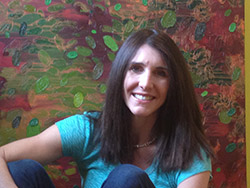 This week’s moderator: Dianne Dudley. Dianne is a Physical Educator for the Ann Arbor Public Schools at Carpenter Elementary. She is the director of the Community High School all-city dance company, Dance Body. She enjoys an active lifestyle with her husband and their four children. She is passionate about creating opportunities for all children to be active. She teaches the free parent/child Dancing Babies creative movement classes for the Ann Arbor Public Library and is a volunteer rec. & ed. coach.
This week’s moderator: Dianne Dudley. Dianne is a Physical Educator for the Ann Arbor Public Schools at Carpenter Elementary. She is the director of the Community High School all-city dance company, Dance Body. She enjoys an active lifestyle with her husband and their four children. She is passionate about creating opportunities for all children to be active. She teaches the free parent/child Dancing Babies creative movement classes for the Ann Arbor Public Library and is a volunteer rec. & ed. coach.
Q: I want my students to attend an event sponsored by UMS or another organization. How can I afford travel expenses?
Community High School was awarded a $350 grant from Michigan Youth Arts (MYA). The all-city dance company will reach out to middle school step teams to attend a University of Michigan Freshman Dance Touring Company performance together during Semester 2. This grant provides an opportunity for more than 60 middle school and high school students to experience a collegiate dance program and performance.
The Michigan Youth Arts’ Arts & Culture Trek Grant program offers grants of up to $500 to Michigan K-12 schools for the transportation cost of an arts and culture field trip. Educators can choose from a list of more than 150 arts and cultural institutions that offer educational programming, exhibits and performances outside the classroom, which enhance the arts and humanities curriculum. The list of available online grants and their due dates for submission can be found on the MYA website.
Q: I want all of my students to be able to attend a UMS performance. How can I afford the cost for so many tickets?
The UMS School Day Performances are offered at a discounted rate for K-12 students. At Community High School, we work with our school PTO to purchase tickets for the entire student body to attend performances together. Our staff and our PTO are committed to providing opportunities to support the Common Core Standards. UMS provides materials for each performance to connect the show to our classroom curriculum. Our teachers use the materials to help facilitate meaningful student engagement before, during, and after the performance.
The UMS Youth Education program includes daytime School Day Performances subsidized for schools, and also Teacher Workshops that energize teaching and learning practices, In-School Visits by performing and teaching artists, and Curriculum Resources to help make direct connections between UMS artists and the classroom.
Q: Why Dance?
I want all of my students to be active so that they can appreciate the physical and mental health benefits of exercise. Dancing is good exercise and a fun way to keep fit. In addition to learning new choreography and dance technique, students work hard throughout the semester to increase their cardiovascular fitness, muscular strength and flexibility. They learn to set realistic goals and learn how to achieve their personal goals. Dance is a great way to raise endorphin and serotonin levels and reduce cortisol levels naturally. I include creative movement and music to all of the lessons I teach at the elementary level. I believe that dancing is a tool that can be used to help bridge our achievement gap. Students bring their own style of dance and experience to the classroom. This can be influenced by their out-of-school opportunities, family and culture. We value, learn, and appreciate dance through every student.
February 14, the Compagnie Käfig modern dance performance will be an excellent field trip opportunity to witness the breath-taking fitness skill-set required to perform with jaw-dropping artistry. This physically demanding dance performance promises a thrilling combination of hip-hop, capoeira dance styles, samba, and acrobatic skills. I will also encourage my students to join dancers from Compagnie Käfig at a free You Can Dance session for an exploration of the company’s movement style on February 13 at the Ann Arbor YMCA.
Do you have questions or comments for Diane about his approach to this performance or about teaching through performance more broadly? Share your responses or questions in the comments section below.
New! Educator Conversations
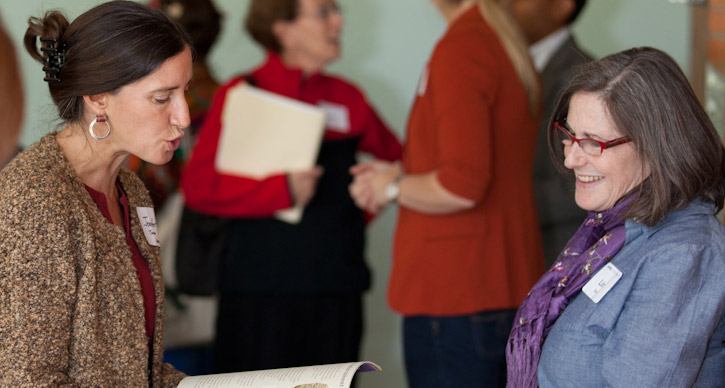
Photo: Emerson School educator Jennifer Tanau and UMS Advisory Committee member Linda Spector at a UMS reception for teachers. Photo by Mark Gjukich Photography.
This season, look for Educator Conversations on UMS Lobby.
Educators will offer suggestions and answer questions about integrating UMS School Day Performances or the arts into classroom curriculum, as well as share advice on organizing a field trip to UMS. To volunteer to be a Teacher Lobby Moderator e-mail umsyouth@umich.edu.
Educator Conversations will take place around UMS School Day Performances. As soon as the conversations are live, we’ll include a link on this page.
- Hubbard Street Dance Chicago with Melissa Poli (Performance September 27)
- Ukulele Orchestra of Great Britain with Katie Ryan (Performance November 12)
- Brooklyn Rider with Emily Barkakati (Performance November 25)
- One Night in Bamako with Jeff Gaynor (Performance February 7)
- Compagnie Käfig with Dianne Dudley (Performance February 13)
- Pedrito Martinez Group with Dan Tolly (Performance March 14)
- Jazz at Lincoln Center Orchestra with Wynton Marsalis with Linda Jones (Performance March 31)
Share you questions or comments below.
Curious About Dance?
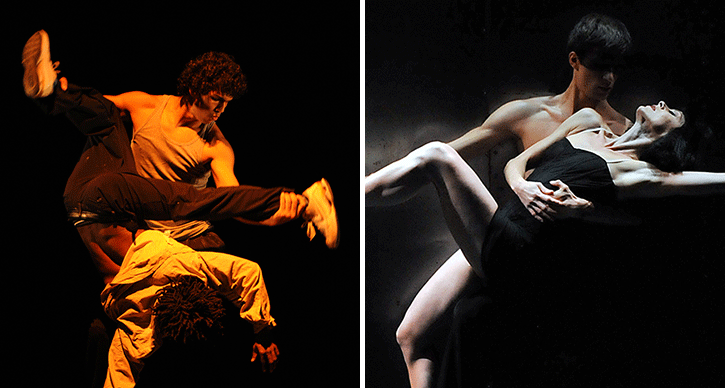
Photo: Compagnie Käfig and Ballet Preljocaj, both part of the 2013-2014 UMS Dance Season.
This season, UMS is launching a set of new programs for both dance enthusiasts and audience members who are curious and want to learn more about dance. Would you like to know more about these programs? Fill out the form below, and we’ll be in touch.
Have questions? Ask us in the comments below.
This initiative is funded in part by Engaging Dance Audiences, a program administered by Dance/USA and made possible with generous funding from the Doris Duke Charitable Foundation.


